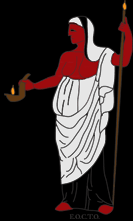
Feast of Plunteria
June 17
(Greek) Ancient: last week of Thargelion (mid-May–mid-June), perhaps 25 Thargelion.
This is the festival for washing (plunteria hiera) the ancient statue of Athena Polias (Guardian of the City); bathing sacred images was a common custom in Greece and elsewhere. (Women have cleaned the temple a few days earlier in a rite called the Kallunteria, which means “to beautify by sweeping.” At this time, the priestess also refills and relights Athena’s eternal flame in the temple.) The day is considered unlucky (apophras) because the Goddess is absent from the city; it begins a rupture of the normal order, a void between the old year (which ends in a month) and the new.
Women remove the peplos (robe) and jewelry from the ancient image of Athena, which is then wrapped and carried in a procession to the washing place. The procession is led by a woman carrying a basket of fig pastries, for the fig is an ancient fertility symbol and was the first cultivated food; the sweetmeats may be offered to the Goddess at the shore. Mounted Epheboi (young men) may also accompany the (veiled) image. It is brought to the shore (for it should be purified in running water, especially salt water), where it is bathed by two girls, the Loutrides (Bathers); the peplos may be cleaned at the same time (perhaps by a priest). That evening the Goddess is returned to the temple in a torchlight procession and is clothed with the clean peplos and adorned with Her jewels. Only the Loutrides and the women who dress and undress the Goddess are permitted to see Her naked.
The ancient statue was of human size or less, carved of olive wood, and probably showed the Goddess seated without weapons. She wore a tall, golden stephane (crown) and She may have had a Gorgoneion (Medusa head) on her breast.
